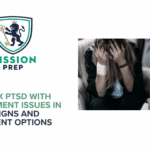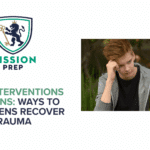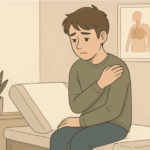PTSD by Proxy in Military Families: How a Parent’s Trauma Affects Their Children


PTSD by proxy in military families is one of the most complex and often overlooked issues faced by children of service members. While it is well-known that those who directly experience trauma are at risk for developing PTSD, the effects on their loved ones, particularly their children, are not as widely understood.
When a parent experiences trauma in the military, whether through combat or other traumatic events, their children may also be impacted. At Mission Prep, we understand that teen mental health and parental PTSD often go hand in hand. We want to help families understand secondary trauma in children and access the right kind of support services for their needs.
This guide can also help raise awareness, as it provides information on:
- What PTSD by proxy in military families is
- How PTSD affects military families
- Signs of stress from parental trauma
- Information on support services for military children
- Trauma-informed care for military kids at Mission Prep
What Is PTSD by Proxy?
It’s important to be aware of the symptoms of secondary traumatic stress to help manage it in effective ways. Teen emotional symptoms of proxy trauma might include:2
Lingering feelings of anger, rage, and sadness about someone’s victimization- Experiencing guilt, shame, or feelings of self-doubt as a bystander
- Loss of hope, pessimism, and cynicism
- Distancing, numbing, and detachment
These symptoms can be very difficult to manage alone, especially as a teen. This is why having access to trauma treatment is crucial to help prevent teens from developing PTSD and reduce their PTSD symptoms.
How Can Teens Get PTSD by Proxy?
According to the Department of Veterans Affairs (VA), when a parent has PTSD, it can lead to child distress and behavior changes.3 For instance, children might either learn unhealthy behaviors that result from directly witnessing a parent’s PTSD symptoms. Alternatively, they might also become traumatized themselves from being in close contact. In either case, PTSD by proxy in military families is a significant problem that can strain the relationship between parents and children.
How Does PTSD Affect Military Families?
Intergenerational trauma is when emotional or psychological symptoms are passed down through family members from one generation to the next.
The intergenerational trauma teens face due to their parent’s PTSD can feel overwhelming – and can take on many different shapes and forms. Understanding how living with a parent with PTSD can affect a military family is the first step toward healing. The following information discusses some of the difficulties to look out for.
Relational Impact of PTSD on Military Families
PTSD symptoms can have a ripple effect on relationships between family members. Some of the many issues that lead to PTSD by proxy in military families and strain relationships include:3
Unwanted reminders of an event: Parent flashbacks can lead to children feeling worried, helpless, and unable to understand their parent’s symptoms- Avoidance of trauma: Avoiding trauma may mean staying away from anything that triggers unwanted emotions. When a parent avoids trauma reminders, children can feel lonely or ignored. They may act out to get attention, but when this doesn’t work, they may feel even more alienated
- Negative thoughts and feelings: When negative emotions take over, or when parents struggle to feel positive ones, children might feel frightened or uncared for
- Feelings of being “on guard”: Parents who are hypervigilant and more protective of their children as a result of their PTSD can cause children to also feel nervous or over-controlled
In addition to traditional symptoms of PTSD, secondary effects like anger and lack of trust can also harm family relationships. Anger is common among veterans and National Guard members with PTSD.4 This anger can lead to negative relationships, fights, and arguments between parents and children.
Another issue is trouble trusting or feeling connected to others, with 5-10% of people with PTSD experiencing lasting relationship problems.5 For instance, children might struggle to understand why it’s difficult to feel close to their parents.
It’s clear that PTSD effects on family dynamics doesn’t just impact the person who experienced trauma. It also extends to their loved ones. For this reason, while it’s important to address personal trauma, it’s good for parents to know that they play a big role in their teen’s overall mental health as well.
Financial Strain of Military Trauma on Families
Research from the VA and the University of Alabama shows that civilians and military members with PTSD are at a higher risk for financial struggles due to issues such as:
Disability- Health care costs
- Unemployment
The researchers also found that the total cost of PTSD in a military member is an estimated $25,684.6 Plus, it isn’t just a lack of work and disability that can lead to financial hardship. Other factors, such as legal issues, can also contribute to the economic burden of PTSD.
For teens with a parent with PTSD, this financial strain can be especially tough, as they might have to take on additional responsibilities, such as paid employment. This can contribute to a phenomenon known as “parentification” – one of the many issues children of parents with mental health challenges like PTSD may face.7
As is clear, from extra responsibilities to experiencing a loss of income, PTSD by proxy in military families has a ripple effect on a child’s development and future.
Psychological Impact of Military Trauma
One of the most significant aspects of military trauma is the psychological impact it can have on children. For instance, children of parents with PTSD are at greater risk of experiencing a variety of mental health issues, including:8
Withdrawal from friends and family- Thought problems
- Aggression
- Anxiety
- Depression
- Attention deficits
- Social relationship problems
Children of parents with PTSD are also at a higher risk for developing PTSD themselves.9 From lack of emotional regulation in military youth to heightened stress, the psychological impact of military trauma on teens can be far-reaching.
For this reason, support for children who have been affected by military trauma is essential. This can include therapy for psychological trauma, support networks, and education about PTSD and its effects.
Signs of Stress From Parental Trauma
Reliving traumatic events- Nightmares
- Sleep problems
- Upsetting responses to certain triggers
- Lack of positive emotions
- Intense fear or sadness
- Irritability
- Anger
- Hypervigilance
- Acting withdrawn
- Feeling numb
These are just some of the many signs that children might be coping with family PTSD. Not all children will show the same signs and symptoms, and some may develop different coping mechanisms. Therefore, it’s important for parents to be aware of how their child might react to traumatic events and provide support that works for them.
Support Services for military children
1. Therapy for Teens With Traumatized Parents
Therapy for teens with traumatized parents is one of the most effective support services for children. There are many different types of therapies that can help reduce the symptoms of PTSD and allow children to heal. Some of these therapies include:
Eye movement desensitization and reprocessing (EMDR): EMDR is a form of psychotherapy that helps children process traumatic experiences by stimulating their bilateral brain activity through eye movements.11- Cognitive behavioral therapy (CBT): This type of therapy focuses on changing negative thought patterns and behaviors to improve emotional well-being. CBT has been shown to improve symptoms of PTSD, anxiety, and depression.12
- Cognitive Processing Therapy (CPT): CPT is another form of cognitive therapy which is often used to treat PTSD, as it focuses on understanding how thoughts and beliefs related to trauma impact emotions and behaviors.13
Determining which of these therapies will help your teen might take some trial and error. A mental health professional can help you explore different options to find the one that works.
2. Support Groups for Teens With PTSD by Proxy
Support groups can help teens with trauma learn how to ask for help, process their emotions, and connect with others who have experienced similar situations.14 These groups can also provide a sense of belonging and reduce feelings of isolation and shame.
To find a support group, you can explore online directories like those at the Anxiety and Depression Association of America (ADAA). Asking local mental health professionals or healthcare providers for recommendations can also be helpful in finding a support group that is right for your teen.
3. Community-Based Support Services
From helping build a support network to providing practical resources, community-based support services can be valuable for people with PTSD. These services are often free or low-cost, making them good options for children, teens, and low-income families.
Some free or low-cost community-based support services include:
Crisis hotlines: These hotlines, such as the 988 National Suicide Lifeline, can provide immediate help in times of distress or crisis. They may also offer information about local support groups and resources.- Peer support groups: Led by people with lived experience, peer support groups offer a safe space to share stories, receive emotional support, and find understanding from others who have been through similar situations.
- Community mental health clinics: These clinics offer mental health services such as therapy and medication management at reduced costs based on income.
- Online support communities: Online support communities and forums can help teens with PTSD connect with others who may be dealing with similar mental health challenges. These can be great resources for children who may not have access to in-person support groups or prefer the anonymity of online interactions.
4. Mentorship Programs for Military Youth
Having a mentor by your side can be one of the best ways to reduce trauma symptoms. Research shows that youth mentorship for children with trauma can lead to:15
Greater self-esteem- Stronger connections to school, peers, and family
- Lower levels of depression
- Less involvement in bullying and fighting
Mentorship programs specifically designed for military youth can be even more beneficial, as they understand the unique challenges and experiences that come with growing up in a military family. Plus, these programs often provide support and guidance from mentors who have experienced PTSD by proxy in military families themselves.
5. Crisis and Emergency Resources for Teens in Military Families
PTSD increases suicide risk by up to 23% in teens.16 Because of this heightened risk, it’s important for families to know there are resources available to help them in times of crisis or an emergency.
One such resource is the Military Crisis Line, which provides 24/7 confidential support via phone, text, or online chat. This service is available for all service members, including teens in military families. They can also provide referrals to local mental health professionals who specialize in working with military families.
In an immediate crisis, it’s always best to reach out to emergency services by dialing 911. Emergency services can respond to both on and off-based housing. If your loved one isn’t in immediate danger but feels as if they need help as soon as possible, it might be time to explore treatment options at Mission Prep.

Trauma-Informed Care for Military Kids at Mission Prep
At Mission Prep, we make it our goal to provide trauma-informed care for military kids at any stage of their mental health recovery. We know how debilitating PTSD by proxy in military families can be, and how critical it is to offer flexible and effective trauma treatment for teens.
Our team uses research-backed therapies combined with the necessary care and compassion for healing. If you’re ready to explore teen PTSD treatment in California or Virginia or outpatient services, reach out to Mission Prep to discover how we can help.
References
- ScienceDirect. (n.d.). Secondary traumatic stress – an overview. Retrieved June 3, 2025, from https://www.sciencedirect.com/topics/medicine-and-dentistry/secondary-traumatic-stress
- Mehlmann-Wicks, J. (2020). Vicarious trauma: signs and strategies for coping. The British Medical Association. https://www.bma.org.uk/advice-and-support/your-wellbeing/vicarious-trauma/vicarious-trauma-signs-and-strategies-for-coping
- National Center for PTSD. (2020, January 14). When a Child’s Parent has PTSD – PTSD: National Center for PTSD. Www.ptsd.va.gov. https://www.ptsd.va.gov/family/effect_parent_ptsd.asp
- Worthen, M., Rathod, S. D., Cohen, G., Sampson, L., Ursano, R., Gifford, R., Fullerton, C., Galea, S., & Ahern, J. (2014). Anger problems and posttraumatic stress disorder in male and female National Guard and Reserve Service members. Journal of Psychiatric Research, 55, 52–58. https://doi.org/10.1016/j.jpsychires.2014.04.004
- National Center for PTSD. (2022, November 8). Relationships – PTSD: National Center for PTSD. Www.ptsd.va.gov. https://www.ptsd.va.gov/family/effect_relationships.asp
- Davis, L. L., Schein, J., Cloutier, M., Gagnon-Sanschagrin, P., Maitland, J., Urganus, A., Guerin, A., Lefebvre, P., & Houle, C. R. (2022). The Economic Burden of Posttraumatic Stress Disorder in the United States From a Societal Perspective. The Journal of Clinical Psychiatry, 83(3). https://doi.org/10.4088/jcp.21m14116
- Stein, M. (2023, December 6). Parentification: The impact of children taking on parental roles in their family | College of Agricultural, Consumer and Environmental Sciences | UIUC. Aces.illinois.edu. https://aces.illinois.edu/news/parentification-impact-children-taking-parental-roles-their-family
- Selimbasic, Z., Sinanovic, O., & Avdibegovic, E. (2012). Psychosocial Problems Among Children of Parents with Posttraumatic Stress Disorder. Medical Archives, 66(5), 304. https://doi.org/10.5455/medarh.2012.66.304-308
- Children significantly more likely to develop PTSD if mother afflicted. (2025). ScienceDaily. https://www.sciencedaily.com/releases/2013/11/131127110607.htm
- CDC. (2024, September 26). Post-traumatic Stress Disorder in Children. Children’s Mental Health. https://www.cdc.gov/children-mental-health/about/post-traumatic-stress-disorder-in-children.html
- U.S. Department of Veterans Affairs. (2014). Eye Movement Desensitization and Reprocessing (EMDR) for PTSD. Va.gov. https://www.ptsd.va.gov/understand_tx/emdr.asp
- American Psychological Association. (2017). Cognitive behavioral therapy (CBT) for treatment of PTSD. American Psychological Association. https://www.apa.org/ptsd-guideline/treatments/cognitive-behavioral-therapy
- American Psychological Association. (2017, July 31). Cognitive processing therapy (CPT). https://www.apa.org/ptsd-guideline/treatments/cognitive-processing-therapy
- U.S. Department of Veterans Affairs. (n.d.). Peer support groups – PTSD: National Center for PTSD. Retrieved June 3, 2025, from https://www.ptsd.va.gov/gethelp/peer_support.asp
- Sox, D., & Min, H. (2023, January 19). Mentoring Children with Traumatic Experiences. The Chronicle of Evidence-Based Mentoring. https://www.evidencebasedmentoring.org/mentoring-children-with-traumatic-experiences/
- Eskander, N., Vadukapuram, R., Zahid, S., Ashraf, S., & Patel, R. S. (2020). Post-traumatic Stress Disorder and Suicidal Behaviors in American Adolescents: Analysis of 159,500 Psychiatric Hospitalizations. Cureus, 12(5). https://doi.org/10.7759/cureus.8017
- U.S. Department of Veterans Affairs. (n.d.). Suicide prevention hotline – Military Crisis Line. Veterans Crisis Line. Retrieved June 3, 2025, from https://www.veteranscrisisline.net/get-help-now/military-crisis-line/



















